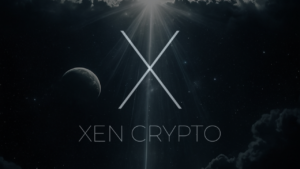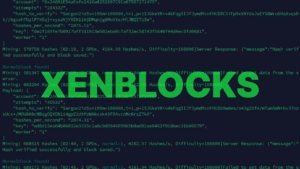Jack Levin is a man working at high speed and always with new ideas. After creating XEN Crypto on Ethereum in October, he proceeded to deploy it on 10 other chains, launch XENFTs, XEN Knights, VMPX on both Bitcoin and Ethereum, BFFY, Devnet, and Fastnet as testnets for X1. Other projects like Xenheads, DBXen, Fenix, Xenon, Xenlon, TGXen, or Xendoge joined him as third-party projects and are part of the XEN ecosystem. All this happened in just nine months.
Now, Levin has unveiled an ambitious plan to build a Tokenizer that will not only lower the barrier to entry for aspiring innovators but also involve burning XEN tokens to fuel the ecosystem’s growth.
What’s the plan
The day after the VMPX ERC-20 launch, Mr. Levin took to Twitter to announce that they’re “building something that allows a person without knowing any code to launch similar projects as VMPX via XEN burn auction (…) Since all those projects (tokens) will use XEN via the auction, XEN will gain value (thru use and burn). Deployers should be able to specify a percentage of fees to be paid to them thru XEN use.” This is the initial plan, and details and blueprints will follow.
July 5th announcement: We are building something that allows a person without knowing any code to launch similar projects as $VMPX via $XEN burn auction... Details and blueprints will be available soon.
— ⓧ Cyphereus Prime 🟧🦇🟦 (@mrJackLevin) July 5, 2023
BRC-20 vs ERC-20 token standard
VMPX is a BRC20 token launched on Bitcoin via the Unisat.io service. Anyone can create a token without any coding experience. The BRC-20 protocol is very simple. It’s a JSON file that gets attached to a single satoshi or sat (the smallest unit of Bitcoin) and makes it suitable for deployment, minting, and transfers. The JSON contains data such as:
- protocol,
- operation (to get things started),
- ticker (ORDI, the first BRC-20 token),
- max supply,
- and the mint limit.
While Inscriptions on Bitcoin are non-fungible, BRC-20s are fungible tokens.
By default, each BRC-20s utility is defined by the code, and the code is, as seen above, very basic.
On Ethereum, the ERC-20 token standard contains mandatory solidity functions like:
- totalSupply (number of tokens contained in an address)
- balanceOf (method for calculating the number of tokens in an address)
- Transfer (method that sends tokens from the sender address to the receiver)
- Approve (method allowing another address to spend tokens on your behalf. On Ethereum, smart contracts that want to gain access to your tokens need to be approved first)
- transferFrom (Approved contract can transferFrom your account to another account as part of a transaction)
- Allowance (the amount one address can spend on behalf of another address)
Optional functions are:
- Name (human-readable name that defines the purpose of the contract),
- Symbol (human-readable ticker like VMPX or XEN)
- Decimals (denomination of the smallest unit of the currency)
While the ERC-20 token standard has more functions, its utility is defined solely by the code, which is standardised for all ERC-20s. It’s ERC-20’s interaction with other smart contracts or abstract off-chain rules that create utility. ERC-20 can, however, have custom functionality.
Developers can add their own custom functions to extend the token’s capabilities, such as token burning, token freezing, or additional access control mechanisms.
While the ERC-20 standard itself is not inherently exploitable, the implementation of an ERC-20 contract can introduce security risks if not implemented correctly. This has to do with the smart contract’s Access Control and Permissions, Transfer and Approval Functions and the way they’re handled, Integer overflow and underflow related to the handling of numeric calculations, or reliance on External Dependencies.
An average user can’t distinguish if an ERC-20 is a standard token or a custom one with more surface attack. That’s why the contracts need to be audited and, in general, require coding experience to be deployed or read. There are, however, always more services offering the deployment of simple tokens, as it’s also possible to do so with NFTs.
XEN Tokenizer
VMPX, being a simple BRC-20, is just data deployed on a single satoshi and doesn’t require any audit because it can’t be exploited by default. VMPX ERC-20 is different because it simulates the Proof of Work and contains more functions.
Mr. Levin intends to give everyone the possibility to create a token like VMPX BRC-20 while burning XEN. It’s going to be an auction, and the auction deployer will be able to set a fee. “You can say 5% of all XEN given to the auction will go to the deployer” he proposed.
The founder of XEN and VMPX stated that “XEN is p2p cash, so use it as currency to develop other projects”. The deployer will set the duration of the auction, and the users will burn XEN to get the tokens. It will be deployed on Ethereum and all other chains where XEN exists, so these will be very simple ERC-20 with 3,4 inputs.
The deployer will need to give the token utility and some game theory to be able to build a community around this kind of token based on first principles.
Staying close to the basic ERC-20 standard without any additional functions means that the smart contracts created through the launchpad will not need any audits.
The launchpad contract will be the factory producing tokens while burning XEN as coal.
Why is this important
There will be tokens of all kinds produced by the XEN factory, and they will all have the same standard, while the use case will depend on the creativity of the deployers. The tokens will be secure by default and ready to start an auction right away.
Since the first BRC-20 deployment on March 8, 36,000 BRC-20s have been created so far, and the market cap surpassed $1 billion at peak time.
It’s estimated that on Ethereum, there are more than 400,000 ERC-20 tokens worth billions of dollars.
It’s obvious that there’s huge demand for tokens, and lowering the barrier to their creation is what Jack Levin is doing.
Adoption through lower barriers to entry is XEN’s mission, and this is its continuation.
The success of NFTs is another example of the market expressing a need. Anyone can get some jpeg images and create NFTs. Most of them do nothing, but some, like CryptoPunks or BAYC, stand out because the community around them creates a special kind of culture or utility. This market is worth billions of dollars now, and it’s predicted to grow further in the coming years. Many NFTs lose value because creating them is trivial and there’s nothing to back them up.
The cost of production is quite important in this case. The cost of production counted in gas is what keeps XEN’s price from falling below a certain level. This is very visible when we look at different chains where gas has different prices. This can be observed with VMPX ERC-20 as well.
$VMPX gas mint auction. $7M worth, 4,500 holders. Credit: @jarosciak pic.twitter.com/XBSzNuKLh2
— ⓧ Cyphereus Prime 🟧🦇🟦 (@mrJackLevin) July 6, 2023
It employs the _doWork function, emulating Proof of Work. The _doWork function essentially represents computational work on a specific mint that the user starts and then pays for in gas. The users needed to perform this work in order to receive VMPX tokens. The mint function of VMPX kept gwei at a relatively stable 40–50 gwei level, which translates to an average price of $0.068 per token.
It’s still too early to draw definitive conclusions on the token price and the cost of production, but the initial data is very promising. What that means is that the tokens may not be completely worthless because humans tend to value things more if they put more money or effort into them.
The token launchpad is important because it burns XEN, increasing its scarcity. Increased scarcity creates demand for XEN, which raises its value. This is an extremely bullish scenario for XEN on all chains.
We’ve seen that each time a new XEN burning project appears, the price goes up as people accumulate to be able to burn. Having perpetual burning in the form of a factory will run mint and burn cycles at a steady rate.
It’s yet unclear if the launchpad will use only XEN burn for time auctions or if it will also implement the _doWork function to create an additional floor price for new tokens in addition to the value of burned XEN.
More details will come soon, and everything is still subject to change.
Conclusion
The ability to easily launch a token without any coding experience and gain royalty fees means opening the space to everyone, not just developers or people with capital to start a project. Burning XEN to deploy a token creates positive price pressure, which attracts more capital and developers as well. There’s no lack of creative ideas among the people, but there’s a lack of skills to implement them. The launchpad eliminates the friction needed for ideas to flourish, and using XEN as the propellant is what makes them more valuable. Jack Levin said that “the community is the value,” and XEN is the unifying force and expression of it. Now, with the launch of the token factory, everyone will have the opportunity to present their idea under a particular ticker symbol to the community and use XEN for that, which will raise the value for all.












